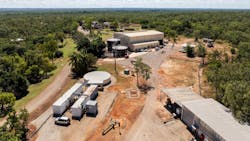Long-term Solution
To address long-term water supply needs, ECT2 designed a full-scale treatment system capable of processing 10 ML/d, sufficient to meet the entire town’s demand during surface water supply interruptions. This system, also based on pre-treatment filtration and SORBIX™ IEX resins, included three independent streams each capable of processing 5 ML/d. This design provided redundancy, allowing maintenance without disrupting water supply. The plant’s ability to regenerate the resin significantly reduced waste and ensured compliance with stringent Australian Drinking Water Guidelines.
Project Execution and Impact
The full-scale plant, commissioned in November 2023, passed a three-month performance test and met all operational criteria, leading to the decommissioning of the interim plant in March 2024. The successful implementation of this project earned the Katherine PFAS Water Treatment Remediation Project the Australasian Land and Groundwater Association Industry Excellence Award for the Best Remedial Project >$1M in November 2019.
Expert Insights
Darrin Stoker, ECT2’s Business Development Manager in Australia, highlighted the pervasive nature of PFAS, present in everyday materials and firefighting foams, and its persistence in the environment. He emphasised the project's unique nature in Australia due to the plant's scale and rapid construction to safeguard the community.
Steve Woodard, Ph.D., P.E., ECT2’s Co-Founder and Chief Innovation Officer, described the groundwater contamination from firefighting foam and that ECT2’s focused approach on scope, schedule, and budget offered the most efficient solution for the project. He noted the selection of technology that could be rapidly deployed and re-energized to minimise waste.
Liam Early, Senior Project Manager at Power and Water Corporation, stressed the urgency due to Katherine’s reliance on contaminated groundwater and the need to lift water restrictions by providing a second water source.
Andy Bishop, P.E., ECT2’s Co-Founder and Senior Vice President of Product Commercialisation, mentioned the dual treatment systems at the RAAF base and Katherine’s water supply. He highlighted ECT2’s existing engagement in Australian projects and the flexibility and rapid deployment of their equipment as key reasons for their selection.
Carl Sueli, ECT2’s General Manager in Australia, attributed their selection of ECT2 to the company’s reputation, reliability, and technical prowess. He expressed pride in being part of a team that consistently delivers on what they say they will do.
Conclusion
ECT2’s rapid and effective response to PFAS contamination at the water treatment plant ensured the Katherine community’s access to safe drinking water. The successful deployment of both interim and full-scale treatment systems demonstrated ECT2’s technical excellence and commitment to public health. This project not only secured water safety for Katherine but also set a benchmark for PFAS remediation efforts globally.
To learn more about our innovative PFAS remediation solutions and how we can help secure safe water supplies, visit ECT2’s PFAS Solutions or watch the videos on our Katherine project by clicking here.





